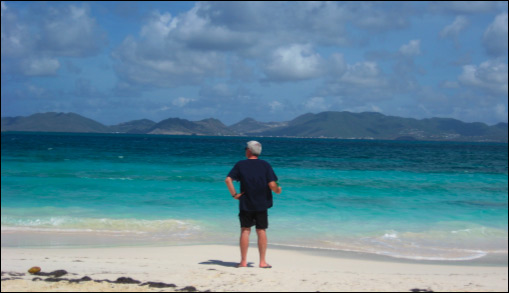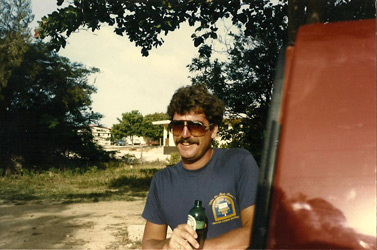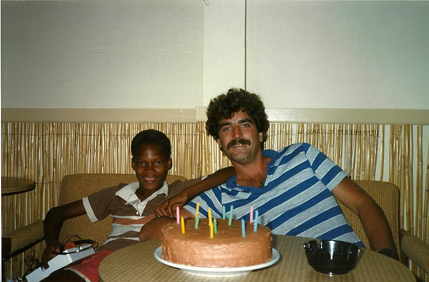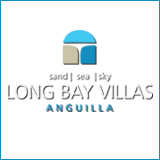-
WELCOME
General Information
Home Best Caribbean Island Anguilla Vacations Air Travel to Anguilla Car Rentals Weather -
SLEEP
-
REALTY & BUSINESS
-
THINGS TO DO
-
EAT
- SPECIAL
- KEEP IN TOUCH
- SAVE 10%
|
|
Gary Rodrigues has been a familiar face in Anguilla for 27 years -- ever since he renovated and reopened one of the island's earliest hotel properties back in the mid-80's. Recently, he sat down with Anguilla-Beaches.com to discuss his efforts to make Anguilla Rising -- a movie about an American veterinarian turned gunrunner who gets caught up in Anguilla's little known 1967 to 1969 revolution.
Whether Gary is more vested in Anguilla -- or writing -- which he has pursued semi-professionally since his teens and professionally since his late-twenties, is hard to say. What we can say is this: it's obvious he's very passionate about both.

We can also say that in the years since he moved back to Massachusetts in 1985, he has maintained strong and active ties to AXA, while enjoying a successful career as a business and financial consultant, executive, and entrepreneur for companies ranging in size from start-up to Fortune 500.
In 2005, while working full-time, he suspended golf activity to focus more of his free time on writing, with the lofty goal of penning a screenplay inspired by Anguilla's revolution -- and bringing the story to life on big screens around the globe.
Today, as he closes in on the realization of a nearly 30-year long dream involving his twin passions, Gary offers a candid, revealing and surprisingly personal conversation with Anguilla-Beaches.
Enjoy!
Right-click here to download the interview with Gary on PDF.
AB: We know that a personal experience inspired you to write the screenplay Anguilla Rising. Can you talk a little bit about this?
GR: Back in 1984, I was sent to Anguilla to renovate and reopen the old cottage colony and restaurant at Corito that had been built by the late Clayton Lloyd. The project had me living in Anguilla for about a year, beginning in September of '84.
Anguilla was still remarkably undeveloped when I arrived. It had just one traffic light in the center of the island at the crossroads by Albert Lake's old supermarket; and, except for the main roads across the island, a good number of the roads, including the one that led to Shoal Bay, were still unpaved.
Gary Rodrigues in Anguilla, 1985

The wire for cable television was still being put up across the island, so most people still didn't have cable TV. If we wanted to watch TV, we had an antenna atop a pole on the roof of our villa. To change channels, I'd climb up on the roof to turn the antenna; from inside, Robin (my girlfriend, then; now, my wife of 24 years) would yell, "GOOD!" when we picked up the signal from St. Maarten.
Tourism was still in its infancy. In fact, it wasn't until Anguilla made Travel & Leisure magazine in December of 1984 -- just a few months after I arrived -- that things started to take off. I remember the cover said, "Where To Go Next." Among the three or four places listed it said, "Sunny, Sexy Anguilla." I was only twenty- seven years old, but I remember thinking, "I've died and gone to heaven!"
The population was only about half of what it is today, and many people still got from Point A to Point B by walking. It was customary to pick people up and give them a lift if you were driving by them as they walked.
In fact, Smitty from Island Harbor worked for me at Corito, so I spent a lot of time at the end of each day heading to and from the East End to enjoy cold refreshments at the original Smitty's (it was a discotheque; and it was the "in" place to go on a Friday or Saturday night.) As I drove from the center of the island to get to Smitty's, boys on the side of the road would yell out, "Hey Uncle Sam, ride, please!"
In short, I fell head over heels in love with Anguilla. The people, beaches, food, and scuba diving were all remarkable. And while any of these attributes was enough to fall in love with, I think it had as much to do with the fact that it was a "special time" in Anguilla in terms of its history and development. I feel fortunate -- maybe blessed is a better choice of words -- to have had the opportunity to enjoy such an experience at that stage of my life.
I suppose that's a long-winded way of saying that Anguilla made a strong and lasting impression on me, and the island and many people living here have been a big part of my life ever since.
Anguilla Rising is simply a manifestation of my fondness and passion for Anguilla -- something planted in me half a lifetime ago, which I knew would eventually spring to life in the form of a novel or movie.
AB: You said it was a "special time" in Anguilla... Can you elaborate?
GR: Anguilla was still pretty much undiscovered, undeveloped, and undisturbed back then. With only a few possible exceptions, for instance, practically every other island in the Caribbean was a decade or two ahead of Anguilla when it came to harnessing tourism as an engine for economic development.
Why was that? The answer can be found in the motivation for Anguilla's revolution.
Prior to 1967, the island had been yoked for 144 years to St. Kitts, 70 miles to the south. Great Britain provided money to a government administration on St. Kitts that was responsible for overseeing three islands. Unfortunately, and apparently unbeknownst to England, Anguilla received only a small fraction of its apportionment because Robert "Papa" Bradshaw, the government administrator on St. Kitts, used most of the money he received for Anguilla to meet needs he perceived as being more important on St. Kitts.
The pennies that Anguilla did receive had to be used to meet basic and essential needs. As a result, there really wasn't any money or wealth to be spread around to build roads, a pier, an electric generating station, a working telephone system, new schools, medical facilities -- or any basic infrastructure upgrades, which would be needed to modernize the island, and to make it strong enough to support and sustain tourism as an industry. So, while nearby islands were enjoying growth in tourism, Anguilla sat languishing -- and stunted -- in a corner of the Caribbean all by itself.
Now along comes the revolution in 1967, which "ends" in 1969 when Great Britain invades Anguilla to regain control of the island. The invasion essentially backfires, and in the face of global embarrassment Mother England has no choice but to provide the engineering and infrastructure upgrades, money, and support needed to bring Anguilla into the modern world -- the improvements Anguilla was asking for all along.
Fast-forward to 1984 when I arrived in Anguilla. Many of the much-needed infrastructure upgrades were just being finished, some were still underway, and a few hadn't even been started. And while tourism was beginning to take off, it was still very much in its infancy. Word was beginning to spread about Anguilla, though, and informed tourists were definitely beginning to discover the island.
With those sparks of tourism, there was a "youthful exuberance" and "buzz" on the island. Perhaps it was driven by the fact that Anguilla was excited to finally be part of the modern world. Perhaps it was driven by the anticipation of things to come.
Whatever the case, I remember stepping off the jet in St. Maarten, and saying, "Wow, look how nice this is!" It wasn't until after I got to see and know Anguilla, however, that I realized that this particular island was different -- it was young and youthful, quiet and undisturbed, warm and welcoming, and it was new and practically untouched.
AB: There really isn't a lot of information out there about Anguilla's revolution, and I suspect there was even less in 1984. How'd you learn so much about it? What sparked your curiosity?
GR: It started on my very first visit to Anguilla. I arrived by ferry, and arrangements had been made for a local businessman to welcome me, and then drive me to a meeting that had been scheduled with some folks who were involved with the property at Corito.
During the drive from Blowing Point to The Valley we talked about Anguilla. I recall the businessman as being incredibly proud -- in fact, he wasted no time in telling me that he had played a big role in the island's revolution. Again, I knew practically nothing about the island, so news about a revolution immediately piqued my interest. I didn't find out until much later, however, that the guy driving me was the leader of the People's Action Movement -- the Opposition Party on St. Kitts when the revolution was sparked.
He was the first of several people who would plant seeds in my head that would sprout over the next 25 years into Anguilla Rising.
Then, over the course of my first few days on the island, I was tasked with putting a plan together to clean up and renovate Corito. It was a beautiful piece of land -- one of just a few spots on the island that was densely populated with mature coconut trees -- but it had pretty much lain dormant for the seven years since Clayton's tragic plane crash. As a result, many of the buildings were in poor condition, and the land was thickly overgrown with weeds, brush, junk, garbage, and snakes, so one of my first moves was to hire Smitty from Island Harbor to put a crew together to begin cleaning up the property.
As we were working together, Smitty and I became good friends, so much so the experience forged a lifelong relationship. He was -- and still is -- very proud of Anguilla and its rich history, and it was from Smitty that I first heard about James Ronald Webster, Anguilla's revolutionary leader. Ronald and Smitty are second or third cousins, I think, and he always talked about Ronald, so in many ways Smitty was the second person to plant the seeds in me that would grow into Anguilla Rising.
Smitty also introduced me to Leander "Bull" Bryan from Island Harbor. Among other part-time jobs he performed for me, Bull was responsible for catching the lobster, grouper, and snapper that were served each evening in the hotel's restaurant.
Bull also showed me where the "The Fountain" was. At the time, you could still climb down a long steel ladder and explore the huge underground cavern, which is now recognized as one of the Amerindian's (Arawak) most important and sacred ceremonial sites dating back 3,000 years.
As we got to know each other, Bull quietly told me of his role in the revolution, when as a teenager he was one of two boys who machete'd wires to a portable electric generator to disrupt the Statehood Beauty Queen Show in February of '67. This was one of several early rebel actions leading up to the revolution. In this regard, Bull was the third person to plant seeds in my brain about the revolution.
Gary celebrates Frantz Lloyd's birthday in 1985

Last, but not least, if one traveled another 500 yards down the narrow road beyond where I lived, you'd end up at the property where veterinarian David Berglund and his wife Charlotte lived when I was living in Anguilla.
Robin and I became very close to the Berglund's, who also introduced us to Raymond and Kathy Haskins, and many other American and British expatriates.
"Bublum," as Dave was (and still is) known, was the "veterinarian from Chicago" alluded to in Donald Westlake's "Under An English Heaven" who was rumored to have ferried M-16's and other military weapons into Anguilla in a small plane, when recruited to do so by Ronald Webster in support of the Anguilla revolution.
David and Charlotte remain some of our dearest friends, and over the years Dave has shared things with me about his role in the revolution that he has never shared with anyone else. In this respect, he was the fourth person to plant seeds inside me, and he has been a huge influence on my effort to make a major motion picture about Anguilla's revolution.
AB: We understand from information posted on your website and Facebook page that in Anguilla Rising you tell Anguilla's revolution story from the perspective of a character who is loosely based on Dr. Berglund. Can you talk a little bit about this?
GR: When I started to contemplate writing the screenplay -- an effort that would be measured in many hundreds of hours spread over a couple of years -- I felt compelled to find a point of view -- or POV -- about the revolution that would take it well beyond the interest level it might enjoy as an incredible and incredulous piece of history.
If I was going to invest the time and energy to write a 100+ page screenplay, I wanted it to come to life in a major way as an epic motion picture for an audience at movie theaters, as opposed to a historical documentary that might be shown to a narrower audience on television, or not be shown at all.
To accomplish this, I wanted a POV that was a bit like opening a window onto the revolution's stage. In other words, could I identify or create a character that offered the perspective of an outsider looking in?
I also wanted a principal character that the global movie-going audience could identify with as an outsider; and, as gravitational forces pulled that character into the revolution, he pulled the audience into it alongside him.
Because I know Dave personally, and because he himself had become ensnared in the revolution while visiting the island in his small plane, a character based on him was perfect. If you think about it, he was one of Anguilla's "original tourists." I mean, who wouldn't relate to a gregarious outsider -- a veterinarian, humanitarian, scuba diver, and cowboy of sorts -- falling so head over heels in love with his newly discovered escape, that when a revolution flares up around him, he joins in -- in a big and unimaginable way.
Creating a character -- and some interesting side-stories based loosely on Bublum -- allowed me to take a historical story that's inherently powerful and interesting to begin with -- and make it even more powerful, persuasive, and exciting for the audience in some fun, romantic, and unthinkable ways.
In fact, it's kind of funny -- I recently attended a Caribbean filmmakers event in New York City, where I had a chance to share the movie concept with a group of other filmmakers. When I was finished, a filmmmaker from Antigua offered, "I love it! It's a bit like the movie James Cameron made about the Titanic, where the ship itself is the stage upon which the Jack (Leonardo DiCaprio) and Rose (Kate Winslet) characters are thrust. In your story, Anguilla's revolution is the stage upon which your characters are thrust. How powerful!"
I couldn't have said it any better.
AB: What's the current status of the movie project?
GR: When I finished writing the first draft of the screenplay in 2006, my original intent was to simply have someone else take it the rest of the way and actually "produce" the movie. It didn't take long to discover, however, that this isn't how things work in Hollywood, where there are literally thousands of good stories competing to be picked up by a major studio and made into a motion picture.
When I figured this out, I came to the realization that, if Anguilla Rising is going to be made into a movie, it'll probably have to be done independently, like so many other good movies are made, today.
To prepare for this, I formed a company in Massachusetts last year called Pyrate Motion Picture Company LLC (also know as Pyrate Films), which is serving as the principal business vehicle for the production of the movie.
Of late, we've been focused on the wide range of activities typically associated with the pre- production and production of a movie. These include: meeting the with government officials in Anguilla to promote the many benefits of film-induced tourism; scouting locations; identifying tax incentives for investors; identifying potential actors and talent; and assembling a team of highly-regarded, veteran moviemakers who'll be involved in the movie's production.
Today, our primary focus is on lining up the US$8 to 10 million needed to make the movie the way we envision it.
AB: How are your efforts to raise the funding coming along?
GR: You know, despite the fact that we're experiencing the toughest economic conditions since the Great Depression, we're making good progress. They say it takes about 10 years to get a movie made. If that's true, we're probably a little bit ahead of the game, considering we've only been focused on this -- part time -- for about 6 years.
Fact is, there are smart people all around the globe who invest in movie projects -- it's what they do. Many people invest in stocks; some invest in commodities; some invest in real estate, art, antiques, and even race horses. Others look for viable movie projects to invest in.
Further still, different people invest for different reasons. One person might invest in a movie project because they simply love movies; another might invest for the thrill (and to see their name roll in the credits); another might invest to take advantage of substantive tax credits and other incentives which can often be realized; yet another might invest for a better expected rate of return, when compared to other investment opportunities.
US$8 to 10 million sounds like a lot of money -- and it is -- but it's not much when compared to other movies of similar scope, size, and potential. Last year, "The Kings Speech," which was made for approximately US$15 million, won four Academy Awards, including Best Picture. It has since grossed more than US$450 million!
While that independent film was made relatively inexpensively, many Hollywood studio movies cost US $100 million or more to produce; and, even though a good many in this category never live up to their potential -- they still do well enough to make money!
Right now, we're doing our best to get the word out about Anguilla Rising as an exciting and viable movie investment opportunity. We've built a website (and a huge repository of historical information) that's beginning to get some attention and traffic. We've also attracted more than 6,000 Facebook fans from 40-plus countries -- which is unheard of for a movie project at this stage of development.
I like to tell interested parties that we're really only one person or investor away from officially "green-lighting" the project. When and/or where will that individual or investment party come from? I firmly believe that he/she is right under our nose.
Why do I believe this?
First and foremost, the Anguilla revolution story is a phenomenal, unknown story, and I believe it's the kind of story people want to see in a movie theater. Why else would 6,000+ people be following us on Facebook? And I should mention that these aren't just Anguillians -- fewer than 400 of the 6,000+ hail from Anguilla, which means that 93% of the fans are from every corner of the globe!
Second, given the more than a million people a year who visit anguilla-beaches.com, he or she could be hearing about this unique opportunity for the first time while reading this interview.
Third, given the large number of high net worth individuals and business people who regularly visit Anguilla, perhaps he/she will come from this base.
Fourth, given what a movie like this can do to fill hotel rooms, maybe one of the hotel owners will come to understand that this is an investment in Anguilla's -- and their hotel's -- future. In fact, in my mind, there isn't a better form of advertising.
Lastly, given the huge number of Hollywood and music industry A-listers who love to visit (and come back to) Anguilla, perhaps he/she will come from within this community. Given the lack of new, untold, character-driven stories in Hollywood, I have to believe that if any of these folks knew more about it, they'd say, "You've got to be kidding me. Why hasn't this been done, yet?"
AB: We agree, and bet that most visitors to Anguilla have no inkling at all about Anguilla's unique history, never mind this relatively recent revolution -- which is a real feel-good story. Hopefully, as you mentioned, anguilla-beaches.com can help spread the message! Is there anything else you'd like to say?
GR: Just a couple more things.
First, Anguilla Rising is actually about more than making a movie. The opportunity, in fact, is about being part of something much larger than that -- it's about helping to bring "film-induced tourism" to the island, and the creation of new and much needed jobs, not only in Anguilla, but in the broader Caribbean community, where there's an effort underway to build out a film industry.
Second, people ask me all the time if the movie can be made for less -- a reasonable question. Of course it can -- thousands of movies are made for less. To keep costs down, however, the producer generally has to shoot at locations that are easy to get to, or conducive to making a movie for less -- on a soundstage, for instance.
Or, they need to use inexpensive talent and film crews, which generally means lining up no-name talent and inexperienced crews. As a result, while a small handful of these films make it to theaters, or go straight to DVD, most of these films never get distributed -- the films simply "sit in the can" never seeing the light of day.
With regard to actors, we expect A-list talent in this movie's principal roles -- A-list talent rarely comes cheaply.
With respect to film crews, we expect to use an experienced team, one that's comprised of seasoned veterans throughout the production team's hierarchy -- again, this costs more.
As for shooting locations, this story is too important to me -- and for Anguilla -- and it needs to represent AXA the way I want to see it represented, so it's critical that it doesn't end up in the hands of someone who'll shoot it on location in Georgia or Louisiana -- or on a soundstage in Detroit that's been built to "look" like Anguilla.
When we do it, it's gonna be done well. $US8 to 10 million will allow us to do it well -- and it'll allow us to shoot it in Anguilla and the Caribbean.
People should also know that I'm a seasoned and successful businessman -- with an MBA -- who has a proven track record for successfully managing multimillion dollar projects and businesses. My personal experience and expertise -- whether it involves my long history with Anguilla, my deep understanding of their revolution, managing businesses and projects for profit, or my writing and the creative arts -- offers a unique assurance that this movie will be done right from both an artistic and a business investment perspective.
Anguilla Rising is a gem of a story, and we're going to make a beautiful, compelling movie that has the potential to win awards and make good money for its investors -- all while creating new jobs, filling hotel rooms, and giving something back to Anguilla.
I'm simply not going to settle for anything short of that -- it's what Anguilla deserves.
Thank you, Gary Rodrigues for an in-depth look at Anguilla Rising!
Anguilla Rising is a true project of passion that tells a remarkable story, and is a unique opportunity for Anguilla and for investors.
Stay up to date with Anguilla Rising...
Click here to visit the Anguilla Rising Facebook page.
Click here to visit the Anguilla Rising Official Website.
For your copy of this interview, right-click here for the PDF.

Tranquility Beach
(Luxury Hotel & Residences)

Long Bay Villas:
The Ultra-Luxury Villas
Sky, Sea & Sand

Santosha Villa Estate:
Anguilla's Most Sophisticated
Ultra-Luxury Villa
Facebook Comments
Have your say about what you just read! Leave a comment in the box below.